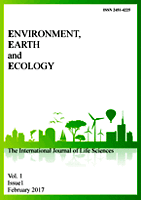ORIGINAL PAPER
Population Structure and Regeneration Status of Most Abundant Medicinal Woody Plants in Mabira Central Forest Reserve Management Zones
| 1 |
Makerere University, Department of Environmental Management |
Environ. Earth Ecol. 2018;2(1):6-11
KEYWORDS
TOPICS
ABSTRACT
In the rural areas 90% of the Ugandans use plants for their medicinal uses. Communities around Mabira Central Forest Reserve (CFR) harvest plants for medicinal purposes. The increased uptake of herbal medicine is a threat to the abundance and health of medicinal trees. This research determined the species population structure and regeneration status of most abundant woody medicinal plant species in Mabira CFR. Sixty nested plots measuring 20×10 m were established adjacent to transects, 20 plots per management zone. The species sampled were identified, counted, and their diameter at breast height (dbh) taken. Their density was computed. Using the dbh classes and density data, dbh distributions were established. Using Kruskal- Wallis test we ascertained if significant differences existed in medicinal plant species densities for size classes in the 3 zones. Using linear regression we got relationship between plant density and dbh. A regression analysis of In (Ni+1) against di was made to cater for the zero values of abundance per hectare. The population had a steep negative slope, meaning that it is stable and naturally replacing itself. There was a general decline in species density with dbh. The <5 dbh size class had the biggest number of individuals per hectare in the production zone. The production zone had a high regeneration potential due to most individuals being in the smallest size class. Density had a negative linear relationship with dbh. There was a significant relationship between dbh and density of species. The tree species sampled were generally naturally regenerating.
Corresponding author
Charles Lwanga Tumuhe 
Makerere University, Department of Environmental Management, 7062, 256 Kampala, Uganda
REFERENCES (12):
| 1. |
Asiimwe S, Namutebi A, Borg-Karlsson A, Kamatenesi-Mugisha M, Oryem-Origa H (2014) Documentation and Consensus of Indigenous knowledge on medicinal plants used by the local communities in Western Uganda. J Nat Prod Pl Res; 4(1):34–42.
|
| 2. |
Joshi AR, Joshi K (2000) Indigenous knowledge and uses of medicinal plants by local communities of the Kali Gandaki Watershed Area, Nepal. J Ethnopharmacol.;73:119–29.
|
| 3. |
Kamatenesi MK, Acipa A, Oryem-Origa H (2011) Medicinal plants of Otwal and Ngai sub counties in Oyam District, Northern Uganda ;7.
|
| 4. |
Kamatenesi-Mugisha M, Oryem-Origa H (2005) Traditional herbal remedies used in the management of sexual impotence and erectile dysfunction in Western Uganda. Afr Health Sci.; 5(1):40–9.
|
| 5. |
Lalfakawma UK, Sahoo S, Roy K, Vanlalhriatpuia PC, Vanalalhluna (2009) Community composition and tree population structure in undisturbed and disturbed tropical semi evergreen forest stands of north-east India, Aizawl: 796 009, India.
|
| 6. |
Lykke AM (1998) Assessment of species composition change in savanna vegetation by means of woody plants' size class distributions and local information. University of Aarhus, Nordlandsvej 68, DK-8240 Risskov, Denmark.
|
| 7. |
Misra R (1968) Ecology work book. – Oxford and IBH, Calcutta.
|
| 8. |
Sahoo UK, Tomar JMS, Upadhyaya K (2008) Phytosociological analysis of Pinus kesiya stands exposed to varying intensities of disturbance at Umiam Watershed in Northeast India. – International Journal of Ecology and Environmental Sciences 34(4):337-346.
|
| 9. |
Tabuti JRS, Mugula BB (2007) The ethno-botany and ecological status of Albizia coriaria Welw. ex Oliv. in Budondo Sub-county, eastern Uganda, Kampala, Uganda.
|
| 10. |
Uganda Gazzette (2015) Indigenous and Complementary Medicine Bill 2015, Vol. VIII: Bill No. 7.
|
| 11. |
WHO (2002) Mental Health Global Action program (mHLGAP). Geneva, Switzeland: World Health Organization.
|
| 12. |
WHO (2013) World Health Organisation strategy on traditional Medicine 2014-2023, Geneva, Switzeland: World Health Organisation.
|








